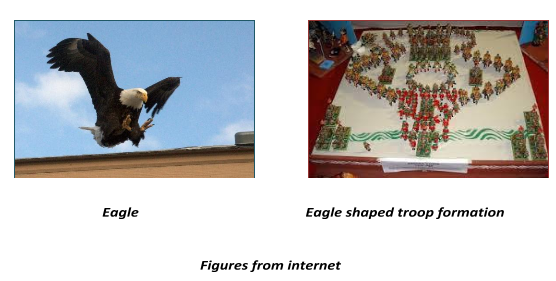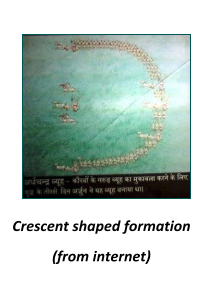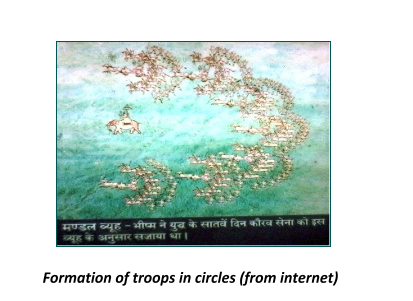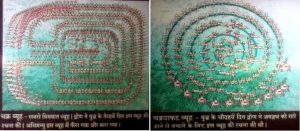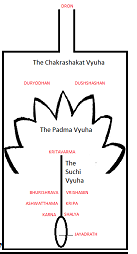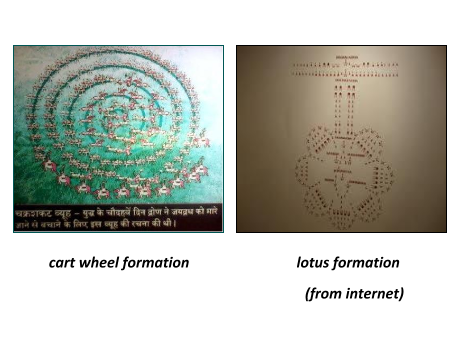TROOP FORMATIONS (VYŪHA)
The nuanced details of the 18 days war is quite interesting. Elaborate details of the Vyūhās (troop formations) on each day of the war are provided. For example, details of troop positions of responsibility in the Vyūha, number of soldiers in vantage points and from which kingdom they were, position in the Vyuha of important warriors and who protects them and so on and so forth. Breezing through this maze of details –
SOME OF THE VYŪHAS FORMED
1st day – Yudhishthirā suggested the formation of Oosi Mugā. However, Arjunā suggested Vajra Vyūha, originally designed by Indrā. Thus, it was Vajrā by the Pāndavās, a combination of Mānushā, Daivā, Gāndharvā and Aasurā by the Kauravās
2nd day – Krounchaa by Pāndavās
3rd day – Ardha Chandra Vyūha by Pāndavās and Garudā by Kauravās
4th day – Vyānā by Kauravās
5th day – Makarā by Kauravās and Senāb by Pāndavās
6th day – Makarā by Pāndavās and Krounchā by Kauravāsc
7th day – Vajrā by Pāndavās and Mandalā by Kauravās
8th day – Koormā by Kauravās and Sringādād by Pāndavās
9th day – Sarvathopathrā by Kauravās
11th day – Krouncha by Pāndavāse and Sakatā by Kauravās
12th day – Garudā by Kauravās and Artha Chandrakarā by Pāndavās
13th day – Padmā by Kauravās.
14th day – Sakatā and inside this, Padma Vyūha and hidden inside this was the Suchi (needle like) Vyūha by Kauravās (this special formation was master-minded by Dronā to protect the Sindh king Jayadrathā, whom Arjunā had vowed to kill before sunset on the 14th day)
16th day – Makara Vyūha by Kauravāsf and Artha-chandra Vyūha by Pāndavās
17th day – Pārhaspathyā by Kauravās
18th day – Sarvathobhadra vyūha* by Kauravāsg, Pāndavās divided their army into 3 units
a. Krouncha vyūha was taught to Indra by the Brahaspathi, Guru of Devās
b. The idea of Sena vyūha was given by Thowmyā, the purohit of Pāndavās
c. At noon on the 6th day, Abhimanyu forms Oosi Mukha vyūha to split into the Kauravā army
d. This vyūha looks like a junction of 4 roads
e. The 3 peak positions were occupied by Bheemā, Yudhishthirā and Sātyaki.
f. Krupā positioned in the right leg was surrounded and protected by soldiers from South India
g. This is a peculiar vyūha master-minded by Salyā. It was decided by Duryodhanā that the entire Kauravā army will move and attack the Pāndavās in pairs.
Micro-details about Vyūhās – some examples
Each formation had a counter formation by the other side. For instance, the counter formation for Sarpa (snake) vyūha was Garuda vyūha. That for Garuda was Krauncha vyūha. Sarpa and Garuda, and heron and Garuda are natural enemies.
Krouncha (heron) vyūha by Yudhishthirā on the 2nd day had the following troop positions:
Krouncha is a bird (heron) with a sharp pointed beak
front – Arjunā
eyes – Kunthibhojā (father of Queen Kunthi) and Chaityā
head – Drupada with 1 lakh soldiers
neck – army of Sātyaki, 1,70,000 soldiers
wings – Bheemā and Dhrushtadhyumnā
right wing – Cholā and Pāndyā kings
back – Yudhishthirā
front of
right wing – Abhimanyu and Sātyaki
left wing – Nakulā and Sahādevā
Garuda (eagle) vyūha by Bheeshmā on the 2nd day:
- beak – Bheeshma
- head – Krupā and Ashvattāmā
- eyes – Dronā and Kruthavarmā
- neck – Trigartha and Jayadrathā with their armies
- body – Duryodhanā, his brothers, Vindhā, Anuvindhā
- tail – Bruhathbālā
Ardhachandra (crescent shaped) vyūha:
left end – Abhimanyu, Gadodhgajā head
centre – Yudhishthirā, Sātyaki, 5 sons of Draupadi
along the ups – army of Drupadā and Virātā
next to them – Neel, Dhrishtaketu, Dhrushtadhyumnā, Shikandi
tip – Arjunā and Krishna
Vajra vyūha (shape of thunderbolt):
 Mandala vyūha (circular formation)
Mandala vyūha (circular formation)
This formation is considered very difficult to penetrate. The Pāndavās countered it by Vajra vyūha
Sarbatomukha vyūha (safe on all sides)
Bheeshma was in the front and guarded by Krupācharya, Kruthavarmā, Shakuni, Jayadrathā, Kambojā, sons of Dhritarāshtra and Trigartha
Chakra vyūha (circular formation)
This formation is considered very difficult to penetrate. The Pāndavās countered it by Vajra vyūha.
Dronā strategised this formation on the 13th day. This formation by Drona had 6 concentric circles under the guard of 6 Mahārathis – Karnā, Dronā, Ashvattāmā, Duhshāsanā, Shalya and Krupācharya. Duryodhanā was positioned at the centre with different warriors at the various layers. Jayadrathā and his army were gate of this vyūha. In this formation, the warriors formed concentric circles and the enemy had not only to penetrate all the layers to reach the centre and defeat the key opponent but also to come out after that. Abhimanyu penetrated the formation successfully and reached the centre but was killed.
Vyūha by Drona on the 14th day
Dronā formed a triple layered vyūha on this day.
1st layer – chakrashakata vyūha, where Dronā was standing guard.
2nd layer – padma vyūha, which was taken charge of by Durmarshana, brother of Duryodhanā
3rd layer – soochimukha (shaped like the needle’s eye) with Karnā, Ashvattāmā, Shalya, Krupācharya, Vrushasena and Bhurisravā guarding it and Jayadrathā at the very end.
WHO FOUGHT WITH WHOM (SAMPLE EXAMPLES)
On the 14th day-
- Arjunā fought with Bhurisravā, who used 73 arrows against Arjunā
- Arjunā also fought with Dhurmarshanā, Dutchādhanā, Dhronā, Srudhāyu (killed), Sudakshinā (killed), Vindhā, Anuvindhā, Dhuryodhanā, Chalā, Karnā, Vrukshasenā, Jayadhtradhā, Krupā, Salyā and Asvattāmā.
- Dhrushtadhyumnā fought with Dronā
- Sāthayki with Dronā
- Yudhishthirā (used 96 bānās/arrows) with Dronā (used 25 bānās/arrows)
- Nakulā fought with Vikarnā
- Sātyaki with Dhurmugā
- Aarsyasrungi with Bheemā
Bheemā also fought with Dronā (he broke 8 chariots of Drona consecutively).
DETAILS OF THE WEAPONS USED
1st day – Bheeshmā used arrow by name Kshirā to bring down the flag of Bheemā. Salyā used Shakti Aayudhā to kill Uttrā.
3rd day- Arjunā used Mahendrāstrā and Aindrāstrā against the Kauravā army.
6th day- Drushtadhyumnā used Mohanāstrā against Duryodhanā’s brothers. To counter this, Dronā used Pragyāstrā.
7th day- Arjunā used Aindrāstrā against the Kauravā army.
10th day- Arjunā used Parjanyāstrā to produce water from the ground for Bheeshmā lying on the bed of arrows.
12th day- Arjunā used Brahmāstrā against the Trigarthās. He also used an arrow called Ardhachandrā against the Trigarthās. Bagadattā used Vaishnavāstrā against Arjunā which was subsequently taken on by Krishna. The astrā turns into a garland called ‘Vaijayanthi’ (Bagadattā comes in the lineage of Narakāsurā who was born of Vishnu and Bhoomā Devi. The Vaishnavāstrā was given as a boon to Narakāsurā by Vishnu on the request of Bhoomā Devi. Hence it is taken back by Krishnā himself)
13th day – Dronā used a weapon named ‘Surabram’ to cut to pieces the sword of Abhimanyu
14th day – Dronā used Divyāstrā against Sātyaki and to counter this Sātyaki used Vārunāstrā. Yudhishthirā used Shakti astrā against Dronā who in turn used Brahmāstrā against Yudhishthirā. This reduced the Shakthi astrā to ashes and Yudhishthirā used Brahmāstrā to counter this. Sātyaki and Bhurisravā used the technique of ‘Prāndham and Uthprāndham’ to fight with each other. These refer to ways of handling/rotating the sword. Arjunā used Aindrāstrā against the Kauravā army. Arjunā used both his hands to aim arrows (he is the only one who can use both his hands to aim arrows. It is for his ability to use both his hands that he is also called Savyasātchi. It is mentioned that he is swifter with his left hand).
15th day – Dronā used Brahmāstrā against the Pānchālā army and killed 20,000 soldiers and also used an arrow named ‘Vaidhāsthigā’ against Dhrushtadhyumnā. Ashvattāmā used ‘Narāyanāstrā’ against the Pāndavā army and Aagneyāstrā against Arjunā. Arjunā used Brahmāstrā against Ashvattāmā. Karnā used the Shakti astrā called ‘Vaijayanthi’ against Gadodhgajā to kill him
17th day – Arjunā used Indrāstrā against the Kauravā army. The Pāndyā king, Malayadhwaja Pāndyā used the Bānā called ‘Karni’ against Ashvattāmā. Karnā used Bhārgavāstrā against the Pandava army. Arjunā used Brahmāstrā, Aindrāstrā, Aagneyāstrā, Vāyuvāstrā and Vajrāstrā against Karnā, who in turn used Nāgāstrā, Parjanyastrā and Vārunāstrā against Arjunā. Arjunā’s Agneyastrā (spewing out fire) was countered by Karnā’s Varunastrā (spewing out water). Karnā’s Parjanyastrā (creates dark clouds and darkens the sky) was countered by Arjunā’s Vāyu astrā (blows winds to clear the clouds). Arjunā’s Vajrāstrā (belonging to Indra and having the capacity to spew out a number of weapons) was countered by Karnā with the astrā which disabled all the weapons Arjunā used the arrow called ‘Anjāligā’* to kill Karnā.
It is mentioned that on the 17th day, midway through the day, Bheemā had in his chariot the following weapons left – 12,000 Ballās (sharp arrows with spikes); 60,000 Bānās/arrows; 2,000 Nārāsangās (arrows with saw-like teeth); 3,000 Pradhārangās, swords, spears and other weapons.
* It is mentioned that this is equivalent to Indra’s Vajrāyudhā. It has 6 wings and can travel very swiftly at great speed. It is considered equivalent to Vishnu’s Chakrā and can cause great damage.
ABOUT THE ASTRĀS
- Mahendrāstrā- killed lots of elephants, horses and soldiers
- Aindrāstrā- similar to Mahendrāstrā but causes more damage
- Aagneyāstrā- caused the sky to darken, fire balls were formed, burnt elephants, horses and soldiers
- Brahmāstrā- caused extensive damage on all fronts. On the 15th day, when Dronā used Brahmāstrā, rivers started flowing in the opposite direction. In fact, when Dronā uses the Brahmāstrā for the second time that day, Rishis like Vishvāmithrā, Vasishta and Jamadhagni come to advise him not to use it unnecessarily against innocent people, people who are ill equipped to counter it. They tell him that a person as learned as Dronā, should not use the astrās indiscriminately fully knowing the after effects of these powerful astrās
- Nārāyanāstrā – burnt whatever came its way, created thunderbolts, shook the earth, oceans churned, rivers flowing towards sea started flowing in opposite direction, and sky became dark
- Brahma Siras – considered the most deadly astrā. Both Arjunā and Ashvattāmā were taught this by Dronā, who in turn was taught this by sage Agastyā. This has the power to destroy the entire world. A huge fireball would spring from the astrā. Loud thunders would be heard, meteorites would fall from the sky and tremors will be felt everywhere. The entire region will not experience rainfall for the next 12 years resulting in severe draught, infertility will be created in men and women. In fact, it is mentioned that when Ashvattāmā directed it towards the foetus in Abhimanyu’s wife Utthrai, the child died in the womb.
Arjunā knew Agneyāstrā, Varunāstrā, Sowmyāstrā, Vayuvāstrā, Vaishnavāstrā, Aindrāstrā, Pāsupathāstrā, Brahmāstrā and Brahma Siras. It is mentioned that only 7 people knew Dhanur Vedā (methods of warfare) fully. They are Bheeshmā, Dronā, Krupā, Arjunā, Ashvattāmā, Karnā and Krishnā. One person knowing much more than these people and much more proficient than these seven people is said to be the Pāndyā king, Malayadhwaja Pāndyā.
NAMES OF THE BOWS
Arjunā’s bow is called Gāndīva. Karnā’s bow given by Parasurāmā is called Vijayā. Karnā’s chariot was also given by Parasurāmā.
NAMES OF THE CHARIOTEERS
- Tārukā was the charioteer of Krishnā
- Visokā of Bheemā
- Indrasenā of Yudhistrā
- Sumitra of Abhimanyu
On the 14th day, Krishnā arranges for a chariot with a flag with Garudā as the symbol to be fully laden with all kinds of weapons. Later that day, Krishnā blows his conch in the “Rishaba Swarā” to call his charioteer Tārugā and asking him to drive the chariot to Sātyaki to help him and give him all the weapons.
FLAG SYMBOLS OF SOME IMPORTANT KINGS
- palm tree and 5 stars – Bheeshmā
- bull – Krupācharya
- kamandalā and arrow – Dronā
- golden color flag with lion’s tail – Ashvattāmā
- snake – Duryodhanā
- silver colored pig – Jayadrathā, king of Sindh
- monkey (Aanjaneyā) – Arjunā
- lion – Bheemā
- cloth used for elephant – Karnā
- golden coloured tree called Kārneekarā – Abhimanyu
- mountain – Malayadhwaja Pāndyā*
* It is interesting to note that the flag (Dhwaja) of the Pāndyā had mountain (named Malayam) and not fish as is known to be the symbol of the later Pāndyā kings.
NAME OF THE CONCHES USED BY SOME IMPORTANT PERSONALITIES
- Pānchajanyā – Krishnā
- Devadattā – Arjunā*
- Paundrā – Bheemā
- Anantavijayā – Yudhishthirā
- Sukoshā – Nakulā
- Manipushpagā – Sahadevā
- Jayathrā – Dhrustadyumnā
- Nandhivardhanā – Sātyaki
These different conches are known to produce different swarās or notes. This helped others in different parts of the battle field to identify the person blowing the conch.
* Story of how Arjunā obtained this conch is explained in detail in Mahābhāratā.
DETAILS OF HORSES AND ELEPHANTS USED
Horses
- Bheeshmā used white horses
- Dronā – red
- Karnā – white
- Bheemā – black
- Arjunā – white
Some of the horses used by Krishnā are Valāgā, Megapushpā, Chaipyā and Sugreevā. Abhimanyu’s chariot was drawn by horses 3 years old
Elephants
- Gadodhgajā’s were Anjanā, Vāmanā and Mahāpadmā
- Bagadattā’s elephant was called Supradeepā/Supradeepikā
- Ashvattāmā was the name of the elephant of Indravarmā, the Malwa king
MISCELLANEOUS INFORMATION
Vishnu Sahasranāmam
Three teachings which are considered the essence of Mahābhārathā are mentioned by Vyasa. They are Vishnu Sahasranamam, Bhagvad Gita and Sanathsujātheyam. It is mentioned by Vyāsā that these three are meant/addressed to people with three different qualities, implying that dharma have to be told in different ways to different people to be understood and appreciated properly. For example, Dhritarāshtra with Tamo gunā was told Sanatsujātheyam by Sanatsujāthar. Arjunā with Rajo gunā was told Bhagvad Gita by Krishnā. Yudhishthirā with Sattva gunā was told Vishnu Sahasranāmam by Bheeshmā, from his death-bed. It is pertinent to note that Vishnu Sahasranāmam told by Bheeshmā to Yudhishthirā is till date recited and heard in many homes, especially in South India. The details provided above have been taken from abridged versions of Mahābhāratā by Vyāsā leaving one wondering how much more details would have been in the original version.
Other assorted information and connections
Two of the Pāndavās, Nakula and Sahādeva are known as experts in handling cows and horses, respectively. In fact, during living incognito during the last year of the vanavās, they worked in cowshed and horse-stable, disguised. Mrga Ayurveda, a branch of Ayurveda, mentions two books on Gava (cow) and Ashva (horse) Ayurveda written by Nakulā (book – Vaidyaka Sarwaswam) and Sahādeva (book – Vyādhi Sindhu Vimardhana). In Ayurvedic ithihās, Punarvasu Atreya is mentioned as the student of Sage Bharadwaja. Agnivesha who authored Agnivesha Tantra (which is now known as Caraka Samhita) is the student of Punarvasu Atreya. It is interesting to note that Drona’s father was sage Bharadwaja and Drona’s teacher’s name was Agnivesha. There is also a book by the name Agnivesha Rāmāyana.
FAMILY HISTORY OF THE KAURAVĀS AND PĀNDAVĀS
Family history from king Nahushā onwards is shown. The ascendants to the throne are highlighted in red. The numbers indicate the succession order. Since the focus is on the kings who ruled, some names are not mentioned. For instance, Karna, the eldest son of Kunti and Mādri’s sons.
Mahābhārata also narrates details of the lives of some kings – whom they married, how they lived, how they ruled, happenings during their reign, etc. For example – Sage Bhrigu’s son is Richikā, whose son is Jamadhagni. His wife is Renukā and their son is Parasurāmā. It is mentioned by Vyāsā that Sage Parasurāmā in his killing spree of the Kshatriyās was asked to give land by sage Kashyapā. While Parasurama went to the southern tip, Kashyapā took charge of the rest of the land. This includes the beautiful mountainous region in the Northern part. It came to be called Kashyapa Meru. It is now known as Kashmir from the word Kashyapa Meru.
Mādri’s sons and their families
- Nakulā + Draupadi Sadhāneegā (died)
- Sahādevā + Draupadi Sruthsenā (died)
Kunti’s sons and their families
- Yudhishthirā + Draupadi Prathivindyā (died)
- Bheemā + Draupadi Sutasomā (died)
- Bheemā + Idumbi Gadodhgajā (died) Anjanaparvā (died)
- Arjunā + Draupadi Sruthakirthi (died)
- Arjunā + Subhadrā Abhimanyu (died)
- Arjunā + Uloobi Aravān (died)
- Arjunā + Chitāngadhā Babruvāhā * (ruled Madurai) (Pāndyā princess)
Karna had four sons, all of whom died in the war.
* Extracts from “Ancient Jaffna” by Mudaliyar C Rasanayagam (1926) –
Page 42 – “The Mahābhārata, which mentions……….Vavravahan, the son of Chitrangada by Arjuna……It is also said that Vavravahan, while fighting against Arjuna, ‘raised his standard which was decorated most beautifully, and which bore the device of a lion in gold’ ……….This standard displaying a lion appears, therefore to have been the one used by the Naga kings of North Ceylon (Naga and Yakkas…before arrival of Vijaya and later Tamils)……the standard of the lion, which appears to have been the emblem of the Nagas of North Ceylon, continued to be the flag of the Ceylon king till the Island was ceded to the British in 1815 AD.”
OTHER INTERESTING DETAILS
Bheeshmā administered the medicine by name ‘Visalyakarani’ to Duryodhanā on the 7th day to relieve him of the pain caused by the deep wounds and to cure his wounds.
The entire army camped near Rivers Iranvathy and Samanthapanchakā.
Mention is also made of river Saraswati. Vyāsā had lived in its banks. It is mentioned that at the end of the 17th day, the surviving kings on the Kauravā side (Salyā, Chitrasenā, Sakuni, Ashvattāmā, Krupā, Kruthavarmā, Sukshenā, Arishtasenā, Dhruthasenā, Jayathsenā and Duryodhanā) went to the banks of Saraswati (two Yojanās from their camp), drank water there and discussed the situation. The mention of river Saraswati is interesting because it is archaeologically shown to have dried up around 2000 BC.
Naming of daughters
The daughters were named after their (king) fathers and/or their state. Examples:
- Kunthi after her father Kunthibhoja
- Draupadi after her father Dhrupada. She is also called Pānchāli after the Pānchālā kingdom she hailed from
- Nakulā and Sahādevā’s mother is Mādri after the Madrā kingdom she hailed from; Gāndhāri after Gāndhārā kingdom
- Devaki (Krishna’s mother) after her father Devakā
Examples from Rāmāyanā
- Kaikeyi after Kekeyā, the kingdom she hailed from
- Sitā was known as Jānaki after her father Janakā and also as Vaidehi after Videha, the kingdom she hailed from
Another such example is Dākshāyani after her father Dakshā
Naming of sons
The sons on the other hand were referred to after their mothers. Examples:
- Abhimanyu as Saubhadrāh (son of Subhadrā)
- Draupadi’s sons are Draupadeyā
- Kunthi’s sons, i.e. the Pāndavās are Kauntheyās
- Karnā was known as Rādheyā after his foster mother Rādhā
Many of the kings also bore names after their kingdom.
Referring to husbands
Another interesting point is how married men were referred to – they were associated with their wife’s name. Few examples –
- Shivā is known as Umāpathy, Umā Maheswaran (meaning husband of Umā), Meenākshi Sundaram (husband of Meenākshi)
- Rāma is known as Jānakirāman, Seethārāman (husband of Jānaki / Sitā)
- Nārāyana is known as Lakshmi Nārāyanan, Lakshmi Narasimhan, Lakshmikant, Lakshmipathy (all meaning husband of Lakshmi), and Madhavan, Srikant, Sripathy, Sridhar, Srinivas (all referring to husband of Sri)
- Krishnā is known as Radhakrishnan, Radheshyam (associated with Radha)
- Muruga is known as Vallināyagan (husband of Valli)
There are many more such names.
It is the other way now – women are called wife of so and so.
Major references used –
- Mahābhāratam by Chakravarthy Rajagopalachariyar, Vanathy Publishers, Chennai.
- Vyāsa Bharatham, Tamil translation by V. Jyothi, Varthaman Publishers, Chennai.
- Mahabharatham Pesugirathu by Cho Ramaswamy, Alliance Publishers, Chennai.
- Encyclopaedia Brittanica
- http://www.cohums.ohio-state.edu/comp/maps.htm
- http://ds.dial.pipex.com/town/parade/nm58/rasa.htm
The author is in the Department of NMR, All India Institute of Medical Sciences, New Delhi.



